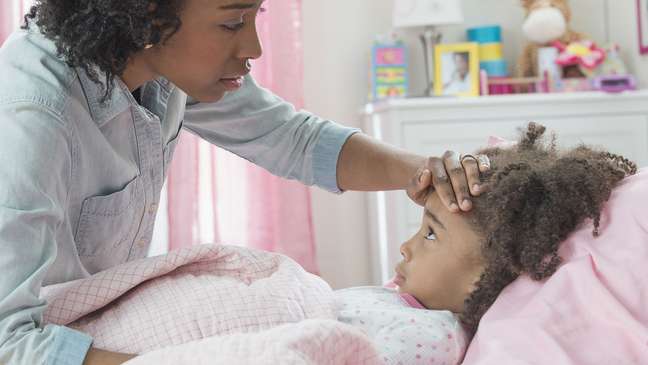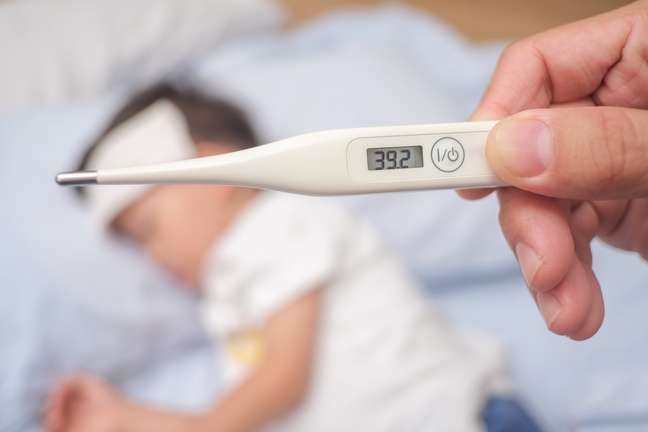Understand what your child’s high body temperature means and when it is a cause for concern
You touch your child and you feel him warmer. Then comes that desperation: is it a fever?? And what does this fever mean? It’s tall? Should I give the antipyretic? Should I rush to the emergency room? There are many doubts, we know, especially for novice parents – but breathe. Let’s go slow!

Calm, in fact, is essential. This is because, contrary to what many think, fever doesn’t always indicate a problem. “We are trying to fight ‘feverphobia'”, explains pediatrician Tadeu Fernandes, president of the Scientific Department of Outpatient Pediatrics of the Brazilian Society of Pediatrics (SBP). “She is our friend, not our enemy. When you have a fever, your body is working against an offending agent.“he says. Therefore, it is not always necessary to do something or try to download it. Sometimes you just have to wait and just observe.
What is fever?
According to Fernandes, fever is the raising of a kind of “thermostat” that we have in the central nervous system, in response to an attack on the organism (caused by viruses or bacteria, for example). ” Fever is a sign, not a disease“says the SBP specialist.” If you fight the fever at minimal levels, at low rates, you will precisely block the child’s body defense against an aggressive agent, “he says.
Is warm skin a sign of a fever?
First of all, it is worth remembering that the way you measure temperature makes a difference. Placing a hand on the forehead or cheek and noticing that the baby is “hot” does not necessarily mean that he has a fever. Yes, she will probably be warmer if she has a fever, but to better understand what the situation is, it is important to use a suitable instrument, such as a thermometer.
How many degrees is considered a fever? 37 degrees is a fever?
In this case, there is no exact answer. The body temperature considered as fever varies according to the reference used.. “The American Academy of Pediatrics (AAP) uses 37.2ºC. The Pediatric SBP treaty uses 37.8ºC. We recently wrote an SBP paper where we used the temperature from 37.2ºC to 37.3ºC as a reference. So, it’s just a theoretical definition. It does not mean that the antipyretic drug should be administered from that number, “explains Tadeu Fernandes.
Is there a better thermometer?
The best tool, according to the doctor, is the digital thermometer, worn under the armpit for three minutes, until it beeps. Infrared, which has become widely used during the pandemic, on the forehead or wrist, is useful for screening but is less specific.
How to lower the fever?
Cold bath, alcohol in the armpit, compresses … Do home methods work to reduce fever in children? At first, the temperature may drop, but the SBP specialist reiterates that none of these techniques are indicated. They can also make the problem worse by causing thermal shocks. If it is necessary to reduce the fever, it is necessary to wait for the effect of the antipyretic indicated by the child’s doctor. While waiting, you can also put it in the bath, at normal temperature, just to calm, relax, distract.

Fever in children: when to medicate?
The measures to be taken in case of fever depend on a few factors. ” The magic words are: general state“, guides the pediatrician. For him, the antipyretic should be used not according to the number shown on the thermometer display, but when the fever bothers the child. “If your child is at 38.5ºC and plays on the playground, let him keep playing. When he is feeling grumpy, tired, you can administer the antipyretic. There is no fixed number,” he says.
The same logic applies to cases where the child does not have such a high fever, but is panting and depressed. “He may need more urgent medical attention than another child who is at 37.8ºC or 38ºC, but who has no other warning signs,” compares the doctor.
When choosing an antipyretic, talk to your child’s pediatrician. Usually, in the first routine consultations, doctors indicate the ideal drug in case of a rise in temperature. The important, according to the SBP pediatrician, is respect the guidelines of the practitioner and do not alternate different antipyretics. “Use the same [remédio] and wait for the time needed between doses, every four hours or every six hours most of the time. The dispersion of different drugs offers greater chances of intoxication, “she warns.
If the temperature rises again before the time indicated for the next dose, observe hydration. Children with a fever tend to lose fluids through sweating. Check if the diaper is wet, if the baby or toddler is still peeing. Decreased frequency can be a sign of dehydration. Make sure you offer liquids, especially water.
When should I go to the emergency room?
The same advice applies to the antipyretic: observe the context and general condition of the child. If you are breathing normally, if you have other symptoms, if you are on the ground, if you are panting. If it’s just a fever, but your baby eats, plays, acts normally, you can wait a little longer and observe. The ideal is to try to make an appointment with the pediatrician, who already knows the medical history and has been following the child for the longest time. If the child is upset or shows other signs of concern, he seeks assistance faster.
“There is a large study, conducted in Spain, which shows that 75% of parents go to the emergency room before the child has a fever for 24 hours,” says Fernandes. ” It is impossible for the doctor to give a definitive diagnosis for such a recent fever because, in general, fever comes first.. Then, 24, 48 or even 72 hours later, a disease, a virus, a hand-foot disease, tonsillitis, pneumonia, meningitis will appear… ”, he exemplifies. The recommendation is to observe what accompanies this symptom.
Fever in infants: yes, it’s a warning sign!
Straight up! The guidelines given so far are not always valid when the baby is newborn. In babies up to two to three months old, fever may be a more prominent sign. Because the immune system is so immature, infections tend to spread more quickly throughout the body. Therefore, the pediatrician recommends that the family seek assistance as soon as possible. “There is a specific protocol for laboratory testing in the cases of children of this age,” she explains.
Baby fever: what could it be?
The rise in temperature is a sign that the body is using a tool – the rise in heat – to expel some offending agent. And who are these agents? “No doubt, 90% of fevers are of viral origin. And, for viral origin, it is worth remembering, it is not necessary to use antibiotics“, says the SBP doctor. Fever can also be a sign of otitis, colds, flu, viruses in the digestive system … Also, it can indicate the presence of bacteria, as in situations of urinary infection, pneumonia, meningitis bacteria, among the others. .
It is also possible that teething gives babies a fever – which should not be a cause for concern. “The eruption of the tooth can cause low fever, because it is an aggression, a rupture. It can cause fever, but it is usually low,” says the specialist. The rise in temperature is sometimes a reaction to some vaccines, since, in general, we speak of a virus (albeit harmless), inserted into the body to stimulate the production of antibodies. This is a normal and expected response.
Therefore, the advice is that parents always remember this fever is a sign that the child’s body’s defense mechanism is working as it should. She watches closely, talks to the pediatrician and avoids panic, which only tends to make the situation worse.
Source: Terra
Benjamin Smith is a fashion journalist and author at Gossipify, known for his coverage of the latest fashion trends and industry insights. He writes about clothing, shoes, accessories, and runway shows, providing in-depth analysis and unique perspectives. He’s respected for his ability to spot emerging designers and trends, and for providing practical fashion advice to readers.







